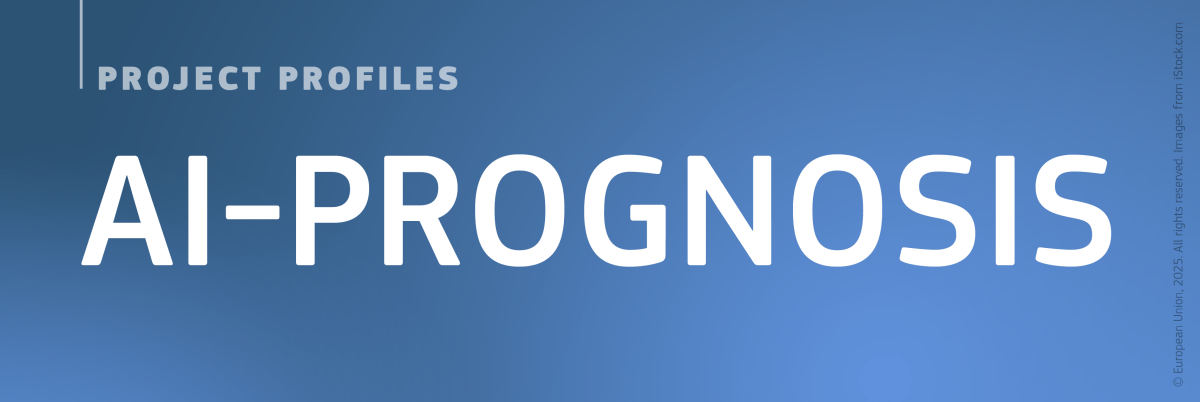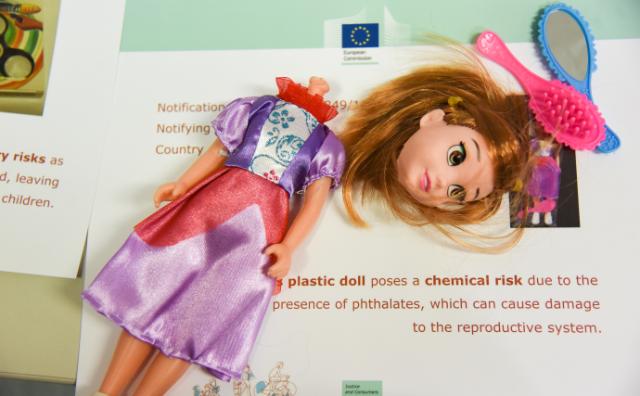Politics
World Parkinson’s Day: Horizon project AI-PROGNOSIS using AI to improve Parkinson’s diagnosis and care

Parkinson’s disease affects more than one million people in the EU and this number is expected to double by 2030, primarily due to an aging population.
To mark World Parkinson’s Day, HaDEA interviewed Prof. Leontios Hadjileontiadis, coordinator of AI-PROGNOSIS, a Horizon Europe research and innovation project aiming to advance Parkinson’s disease diagnosis and care through novel predictive models combined with digital biomarkers from everyday devices, such as smartphones and smartwatches.
Prof. Hadjileontiadis, tell us more about AI-PROGNOSIS.
AI-PROGNOSIS is focused on improving Parkinson’s disease diagnosis and care through predictive models driven by artificial intelligence (AI) and digital biomarkers from everyday devices. The project aims to enhance early detection, predict disease progression and optimise treatment responses, thereby personalising patient care. By leveraging data from smartphones and smartwatches, AI-PROGNOSIS offers valuable insights into individual risk and treatment efficacy, ultimately improving the quality of life for those with Parkinson’s disease.
What can you tell us about your project’s use of AI? Have you encountered any challenges in integrating your solutions in broader healthcare systems?
The lack of interoperability with legacy electronic health record systems has made integrating AI tools into existing clinical workflows difficult. Many healthcare institutions still use outdated systems not designed to support advanced AI technologies. Building trust and acceptance among healthcare professionals and patients has also been a challenge. There is often scepticism about the accuracy and reliability of AI models and concerns about the potential for AI to replace human roles in healthcare. Overcoming these concerns requires continuous education and demonstration of the AI tools’ benefits and reliability.
Navigating the complex regulatory landscape for AI in healthcare has added to the challenges. Ensuring that AI tools meet all legal and ethical standards is essential for their adoption and use. Additionally, accessing existing datasets has been difficult due to data ownership and sharing restrictions, which limit the amount of data available for training AI models. Recruiting patients for studies and trials has also been challenging, as it requires significant time and resources to ensure a diverse and representative sample.
These challenges underscore the importance of a collaborative and adaptive approach in developing and implementing AI solutions in healthcare, ensuring they are both effective and widely accepted.
Could you elaborate on this collaborative and adaptive approach?
AI-PROGNOSIS has adopted a comprehensive and inclusive approach to identify the needs of key stakeholders, including patients, healthcare professionals, and researchers. The project emphasises continuous engagement and collaboration with these groups to ensure the tools developed are user-friendly and meet their needs.
This includes:
- Multidisciplinary workshops: AI-PROGNOSIS organises workshops bringing together experts from various fields to discuss and refine project goals and methodologies;
- Patient involvement: Patients are actively involved in the design and testing phases, providing valuable feedback on usability and functionality;
- Input from health professionals: Regular consultations with doctors and therapists help tailor the AI tools to clinical workflows and practical needs;
-
Input from the external advisory board: Expert guidance on the ethical implementation, strategic integration, industry perspectives and impactful application of AI-PROGNOSIS output in Parkinson’s disease research and care.
This collaborative and iterative approach ensures that AI-PROGNOSIS remains aligned with the real-world needs of its stakeholders, enhancing its impact on Parkinson’s diagnosis and care.
Having consulted with numerous stakeholders, can you give us an example of how this feedback has been used?
For example, in one of the focus groups that we ran, healthcare professionals shared how challenging it was to be informed about their patients’ changing symptoms across the course of the illness. This insight helped us develop the mAI-Insights application, which allows healthcare professionals to receive frequent updates and alerts about their patients’ symptoms.*
With the project running until 2027, how important is the EU’s financial support throughout the project life cycle?
The support of EU funding is crucial for our project. It provides financial resources for extensive research, developing advanced AI models, and integrating digital biomarkers from everyday devices. EU funding under the Horizon Europe programme also facilitates collaboration among multidisciplinary European teams, ensuring that the project benefits from diverse expertise and perspectives. Additionally, this support helps navigate regulatory challenges and promotes the adoption of innovative solutions in healthcare systems. Without EU funding, achieving the project’s ambitious goals and significantly impacting Parkinson’s diagnosis and care would be much more challenging.
*The project also features two other applications: mAI-Health for persons with suspected Parkinson’s to track their personalised risk and mAI-CARE for persons with diganosed Parkinson’s to track symptoms, disease progression and treatment efficacy.
Background
Horizon Europe is the research and innovation programme of the EU for the period 2021-2027. The aims of Cluster 1 ‘Health’ include improving and protecting the health and well-being of citizens of all ages by generating new knowledge, developing innovative solutions and integrating where relevant a gender perspective to prevent, diagnose, monitor, treat and cure diseases. Horizon 2020 (H2020) was the EU’s multiannual funding programme between 2014 and 2020.
Politics
EIT Water Info Session: Deep dive into the evaluation process of the Call



DISCLAIMER: Information and opinions reproduced in the articles are the ones of those stating them and it is their own responsibility. Publication in The European Times does not automatically means endorsement of the view, but the right to express it.
DISCLAIMER TRANSLATIONS: All articles in this site are published in English. The translated versions are done through an automated process known as neural translations. If in doubt, always refer to the original article. Thank you for understanding.

– Advertisement –
– Advertisement –
EIT Water Info Session | Deep dive into the evaluation process of the Call
The May edition of the EIT Water Info Session will spotlight the timeline, key stages, and qualitative aspects of the evaluation process following the closure of the Call for Proposals for a new Knowledge and Innovation Community (KIC) in the water, marine, and maritime sectors. Tailored for prospective applicants, the session will offer valuable insights into the strategic objectives of the call, the evaluation criteria, and the legal considerations involved.
The online session will open with remarks from Stefan Dobrev, Chair of the EIT Governing Board, and David Tas from EIT, setting the stage for an in-depth presentation by Laura Hanin, the Call’s coordinator, who will walk participants through the evaluation process and selection criteria. Beata Hartwig, EIT Legal Officer, will provide guidance on the legal framework and compliance requirements. The event will wrap up with a Q&A segment, giving attendees the chance to engage directly with the EIT team and get clarity on any outstanding questions.
| 10:00 – 10:05 | Setting the scene — David Tas (Head of Supervision and Monitoring Unit, EIT) |
| 10:05 – 10:20 | Welcome address – Stefan Dobrev (EIT Governing Board Chair) |
| 10:20 – 11:00 | Evaluation process and Call Criteria — Laura Hanin (EIT Water Call Coordinator) |
| 11:00 – 11:15 | Legal aspects of the EIT Water Call – Beata Hartwig (EIT Legal Officer) |
| 11:15 – 12:00 | Questions and Answers |
Register Here
Source link
More from the author
– EXCLUSIVE CONTENT –
Politics
Toy safety: deal on new measures to protect children’s health | News

On Thursday evening, Parliament and Council negotiators reached a provisional agreement on new EU toy safety rules to enhance the protection of children’s health and development. The deal strengthens the role of economic operators in improving toy safety, and clarifies requirements for safety warnings and the digital product passport (DPP). It expands the list of prohibited substances in toys.
Ban on harmful chemicals
In addition to the existing prohibition of carcinogenic, mutagenic, or reproductive toxic (CRM) substances, the agreed text also bans chemicals that pose particular risks to children, such as endocrine disruptors, substances harmful to the respiratory system, and chemicals that are toxic for the skin and other organs. At Parliament’s insistence, the new rules will ban the intended use of per- and polyfluorinated alkyl substances (PFASs) and the most dangerous types of bisphenols. Allergenic fragrances will be banned in toys for children under 36 months and in toys meant to be placed in the mouth.
Safety assessment
Before placing a toy on the market, manufacturers will have to carry out a safety assessment on all potential hazards − chemical, physical, mechanical, and electrical. The assessment will also have to test toys’ flammability, hygiene, and radioactivity, and take children’s specific vulnerabilities into account. For example manufacturers should, where appropriate, ensure that digital toys do not pose risks to children’s mental health − as requested by Parliament negotiators.
Economic operators and online marketplaces
The agreed rules clarify the obligations of economic operators, such as manufacturers, importers, and distributors. This also includes fulfillment service providers (companies responsible for storing, packaging, and dispatching toys). Changes were also introduced to align the agreed text with other legislation, such as the General Product Safety Regulation, the Ecodesign framework and the Digital Services Act.
The text clarifies requirements for online marketplaces, reflecting their growing role in the sale and promotion of toys. For example, marketplaces will have to design their platforms so as to allow sellers to display the CE mark, safety warnings, and a link (such as a QR code) to the digital product passport, to be visible before the purchase is completed.
Digital product passport
All toys sold in the EU will have to bear a clearly visible digital product passport (DPP) showing compliance with the relevant safety rules. The DPP will enhance the traceability of toys and make market surveillance and customs checks simpler and more efficient. It will also offer consumers easy access to safety information and warnings, via a QR code, for example.
Quote
Rapporteur Marion Walsmann (EPP, Germany) said: “Although we already have the safest toys in the world in the European Union, one in five products categorised as dangerous and withdrawn from the market by the EU was a toy. It was therefore very important to revise the 2009 Toy Safety Directive. We are reducing the risks posed by hazardous chemicals in toys and ensuring better labelling, including in online retail. We have also future-proofed the regulation: the Commission will be able to react more quickly to new scientific findings on chemical substances.. The new Toy Safety Regulation sends out a strong signal: for the protection of our children, fair competition and for Europe as a business location.”
Next steps
Parliament and the Council have concluded an “early second reading agreement” (the negotiation took place after Parliament’s first reading was adopted in plenary). The Council is now expected to adopt this agreement formally, and Parliament will then have to endorse the text in plenary, in second reading.
The regulation will enter into force 20 days after its publication in the EU Official Journal. Member states will then have 54 months to comply with the provisions.
Politics
Child protection: Council and Parliament strike a deal on a law to make toys safer

DISCLAIMER OPINIONS: The opinions of the authors or reproduced in the articles are the ones of those stating them and it is their own responsibility. Should you find any incorrections you can always contact the newsdesk to seek a correction or right of replay.
DISCLAIMER TRANSLATIONS: All articles in this site are published in English. The translated versions are done through an automated process known as neural translations. If in doubt, always refer to the original article. Thank you for understanding.
DISCLAIMER PHOTOS: We mostly used photos images that are readily available online, from free sources, or from the people promoting the news. If by any chance it happens that we have used one of your copyrighted photos, please do not hesitate to contact us and we will take it down without question. We do not make profits as this is a not for profit project to give voice to the voiceless while giving them a platform to be informed also of general news, and it is completely free.
-

 EU & the World7 days ago
EU & the World7 days agoWho Is Laura Loomer? 5 Things to Know About the Far-Right Activist
-

 EU & the World7 days ago
EU & the World7 days agoWho Is Buying TikTok? What Might Happen to the App
-

 EU & the World2 days ago
EU & the World2 days agoWhere to Watch the Masters: Can I Stream the Live Coverage?
-

 Sports6 days ago
Sports6 days agoSerie A 2024-2025: Torino-Verona, the likely lineups
-

 Sports6 days ago
Sports6 days agoAlexander Zverev dates Jannik Sinner in Rome final
-

 Sports5 days ago
Sports5 days agoElisa Longo Borghini: sports career, personal interests, family, awards and honors
-

 Sports1 day ago
Sports1 day agoCarlos Alcaraz takes big risk but hits semifinal in Monte Carlo
-

 Health & Society6 days ago
Health & Society6 days agoHydration Hacks – The Underrated Role of Water in Natural Healing









